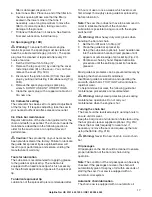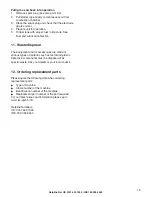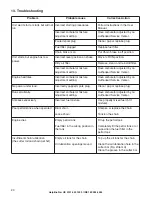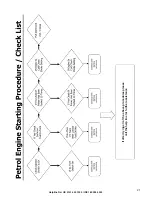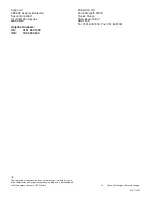
11
Helpline No: UK 0151 649 1500 / IRE 189 094 6244
Read all these instructions before operating this
product and save these instructions.
1. DO NOT operate a chain saw with one hand!
Serious injury to the operator, helpers,
bystanders, or any combination of these persons
may result from one-handed operation. A chain
saw is intended for two-handed use.
2.
Do NOT use the saw if you are tired, ill or under
the influence of alcohol and/or drugs.
3.
Use safety footwear, snug-fitting clothing,
protective gloves, and eye, hearing and head
protection devices.
4.
Use caution when handling fuel. Move the chain
saw at least 10 feet (3m) from the fueling point
before starting the engine.
5.
DO NOT allow other persons to be near when
starting or cutting with the chain saw. Keep
bystanders and animals out of the work area.
6.
DO NOT start cutting until you have a clear work
area, secure footing, and a planned retreat path
from the falling tree.
7.
Keep all parts of your body away from the saw
chain when the engine is running.
8.
Before you start the engine, make sure that the
saw chain is not contacting anything.
9.
Carry the chain saw with the engine stopped, the
guide bar and saw chain to the rear, and the
exhaust away from your body.
10.
NEVER use a chainsaw which is damaged,
incorrectly set or incompletely and loosely
assembled. Make sure that the chainsaw stops
when the chain brake is applied.
11. Shut off the engine before setting the chain saw
down.
12. Use extreme caution when cutting small size
brush and saplings because slender material
may catch the saw chain and be whipped toward
you or pull you off balance.
13. When cutting a limb that is under tension, be
alert for springback so that you will not be struck
when the tension in the wood fibers is released.
14. Keep the handles dry, clean, and free of oil or
fuel mixture.
15. Operate the chain saw only in well-ventilated
areas.
16. DO NOT operate a chain saw in a tree unless
you have been specifically trained to do so.
17. All chain saw service, other than the items listed
in the user manual safety and maintenance
instructions, should be performed by competent
chain saw service personnel.
18. When transporting your chain saw, use the
appropriate guide bar scabbard.
19. DO NOT operate your chain saw near or around
flammable liquids or gases whether in or out of
doors. An explosion and/or fire may result.
20. Do not tank fuel, oil or lubrication when the
engine of chain saw is running.
21. USE THE RIGHT TOOL: Cut wood only. Do not
use the chain saw for purposes for which it was
not intended. For example, do not use the chain
saw for cutting plastic, masonry, or non building
materials.
22. The engine will create toxic exhaust fumes as
soon as the engine is started. Never work in
enclosed rooms or in rooms with poor ventilation.
Note:
The following appendix is primarily for the end
user or occasional user. The chainsaw is designed for
occasional use by home owners, garden owners and
campers and is for general work such as stump-
grubbing, cutting firewood, etc. It is not designed for
lengthy use. If it is used for a lengthy period, the
vibrations it causes in the hands of the user may
result in circulation problems (white finger syndrome).
Kickback may occur when the nose or tip of the
guide bar touches an object, or when the wood
closes in and pinches the saw chain in the cut. If the
bar tip contacts, it may cause a lightning-fast reverse
reaction, kicking the guide bar up and back towards
the operator. Pinching the saw chain along the top of
the guide bar may push the guide bar rapidly back
towards the operator. Either of these reactions may
cause you to loose control of the saw, which could
result in serious personal injury. Do not rely
exclusively upon the safety devices built into your
saw. As a chain saw user, you should take several
steps to keep your cutting jobs free from accident or
injury.
1.
With a basic understanding of kickback, you can
reduce or eliminate the element of surprise.
Sudden surprise contributes to accidents.
2.
Keep a good firm grip on the saw with both
hands, the right hand on the rear handle, and the
left hand on the front handle, when the engine is
running. Use a firm grip with thumbs and fingers
encircling the chain saw handles. A firm grip will
help you reduce kickback and maintain control of
the saw. Donʼt let go.
3.
Make sure that the area in which you are cutting
is free from obstructions. Do not let the nose of
the guide bar contact a log, branch, or any other
obstruction which could be hit while you are
operating the saw.
4.
Cut at high engine speeds.
5.
Do not overreach or cut above shoulder height.
6.
Follow manufacturerʼs sharpening and
maintenance instructions for the saw chain.
7.
Only use replacement bars and chains specified
by the manufacturer or the equivalent.

















